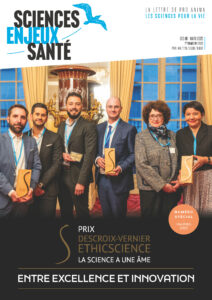
EU Roadmap recommendations, Twin transition in regulatory toxicology, EMA’s reflections on AI, India’s regulation of biobanks and more
News on non-animal methods
OCTOBER 14 - 18, 2024NEWS, REPORTS & POSITION STATEMENTS
1. EU Roadmap towards phasing out animal testing for chemical safety assessments : Recommendations from a multi-stakeholder Roundtable
A new collective document shares key recommendations from the Multi-stakeholder Roundtable at the initiative of 5 international NGOs that took place June 18, 2024 on the EC Roadmap towards phasing out animal testing for chemical safety assessments.
The event brought together 41 key stakeholders with expertise from across EU institutions, national regulators, industry, environmental protection and human health : DG GROW, DG ENV and JRC, EPAA, ECHA, EMA, RIVM, KEMI, BfR, Ministry of Env of Austria, industry representatives, organizations, academia and more.
The report that gathers key elements from the open discussions and perspectives of the roundtable is now available and set to help inform participants of the upcoming EC Workshop on the Roadmap, this October 25, 2024.
2. A twin transition in regulatory toxicology : moving toward Chemicals 2.0 and phasing out animal testing
The European regulatory framework on chemicals is at a crossroads. There are calls for the framework to be more effective, by better protecting people and the environment. There is also room for it to be more efficient and cost-effective, by harmonizing assessment practices across sectors and avoiding the need for unnecessary testing. At the same time, there is a political commitment to phase out animal testing in chemical safety assessments.
In this commentary, the authors argue that these needs are not at odds with each other. On the contrary, the European Commission’s roadmap to phase out animal testing could also be the transition pathway to a more efficient, effective, and sustainable regulatory ecosystem. Central to this proposal is a framework based on biological reasoning in which biological questions can be answered by a choice of methods, with non-animal methods progressively becoming the only choice.
3. EFSA : Review of NAMs for application in risk assessment of nanoparticles in the food and feed sector
New Approach Methodologies (NAMs), broadly understood to include in silico, in chemico, in vitro and ex vivo methods, show great potential in advancing risk assessment albeit their regulatory implementation is lagging. The EFSA Guidance on risk assessment of nanomaterials (EFSA Guidance on Nano‐RA) suggests nano‐specific risk assessment is best achieved through Integrated Approaches to Testing and Assessment (IATAs) with NAMs as the first choice to generate new information.
However, applying NAMs to nanomaterials (NMs) also poses considerable challenges such as issues related to dispersion stability, dosimetry, transformations or assay interferences. The review covers NAMs that will be potentially useful for risk assessment of NMs in the food and feed sector. It follows the structure of the EFSA Guidance on Nano‐RA and expands it, where needed, to support decision‐making in selection of NAMs for NM risk assessment.
4. EMA : reflection paper on AI in medicinal product lifecycle guidance
The reflection paper on the use of AI in the lifecycle of medicines outlines the current thinking on the use of artificial intelligence (AI) to support the safe and effective development, regulation and use of human and veterinary medicines. This paper reflects on principles relevant to the application of AI and machine learning (ML) at any step of a medicines’ lifecycle, from drug discovery to the post-authorisation setting.
The Methodology Working party developed the paper with support from the Big Data Steering Group.
5. Lush Prize work : new Roadmap to modernize chemical safety testing in the UK & replace the use of animals
The need for industry wide transition from a scientific paradigm reliant on animal research to one which is more fit for purpose, biologically relevant and animal free has led some governments to use the idea of a ‘roadmap’ to plan the journey and the stages needed to achieve the desired goal. It is highly likely that the UK as a whole would benefit from such a roadmap.
As part of Lush Prize’s wider work prior to the 2023 conference, the Ethical Consumer Research Association was asked to explore what a roadmap for modernizing chemical safety testing in the UK might look like. This short report is designed to answer the question : ‘what might a roadmap for the UK look like?’
Read more and download the full report
6. Future integration of NAMs : Meeting report to the Science Board to the FDA
FDA asked input from the Science Board on how the agency can enhance its existing approaches to support the development, qualification, and implementation of alternative methods for regulatory use that can replace, reduce, and refine animal testing (i.e., the 3Rs), improve predictivity of nonclinical testing and build confidence and experience with NAMs to inform future use in regulatory decision-making.
The Science Board, in response to the FDA charge, developed six sets of recommendations in the report titled ‘Potential Approaches to Drive Future Integration of New Alternative Methods for Regulatory Decision-Making’.
7. ACI workshop report : NAMs for the in vitro assessment of cleaning products for respiratory irritation
The use of in vitro new approach methodologies (NAMs) to assess respiratory irritation depends on several factors, including the specifics of exposure methods and cell/tissue-based test systems. This topic was examined in the context of human health risk assessment for cleaning products at a 1‑day public workshop held in March 2023, organized by the American Cleaning Institute (ACI).
The goals of this workshop were to (1) review in vitro NAMs for evaluation of respiratory irritation, (2) examine different perspectives on current challenges and suggested solutions, and (3) publish a manuscript of the proceedings.
8. Analysis : Why precision medicine in India can’t advance without biobank laws
Precision medicine is bringing in a new era of personalized healthcare. The Indian precision medicine market is estimated to be growing at a CAGR (Compound annual growth rate) of 16% and is expected to be worth more than $5 billion by 2030, according to industry estimates.
The U.K., the U.S., Japan, China, and many European countries have laws or comprehensive regulations that address several biobanking issues, including informed consent, withdrawal rights, privacy, and data protection. At present, India’s regulation of biobanks is inconsistent, with gaps that could undermine public trust and limit the potential of precision medicine. Without proper regulations, many pharmaceutical companies, including those abroad, will have access to samples from India. In the absence of an overarching law, Indians could be deprived of the ownership of biological samples and/or the data thereof, and the profits from the resulting research findings.
TOOLS, PLATFORMS, CALLS
9. JRC Summer School on non-animal approaches in science : Changing the paradigm
Non-animal approaches not only address the ethical aspects of using animals in science, but also offer huge advantages for conducting human and environmental relevant research and testing, whether it be for studying disease mechanisms, developing new therapies or ensuring the safe and sustainable use of chemicals. Cutting-edge technologies including induced pluripotent stem cells, organ-on-chip, computational modeling and artificial intelligence are being exploited for world class science that benefits our society and supports sustainable development and innovation.
The JRC Summer School is open to students (Master or PhD) or early-career scientists (max. 4 years after completing studies) with a strong interest in non-animal approaches working in relevant fields of research and application. The maximum number of participants will be 120.
The application process will open on November 5, 2024.
INDUSTRY, BIOTECH & PARTNERSHIPS
10. InSphero and FDA’s NCTR : A significant advancement in predicting DILI
InSphero, leader in 3D cell culture technology, and scientists from the U.S. Food and Drug Administration’s (FDA) National Center for Toxicological Research (NCTR) have published the largest-ever benchmarking study on liver toxicity using 3D InSight Human Liver Microtissues that uniquely combine hepatocytes from ten individuals with other important liver cell types to recapitulate the physiology accurately.
The study tested the hepatotoxicity of 152 FDA-approved drugs, providing compelling evidence that this high-throughput safety platform can play a crucial role in early-stage drug safety testing, potentially reducing attrition rates. Most notably, 3D liver microtissues correctly flagged 80% of the compounds that were later withdrawn due to liver safety concerns, while 89% of the safe drugs were labeled accurately, too. The results highlight the unprecedented predictive accuracy, particularly for liver-toxic drugs targeting the nervous system with an impressive 90% success rate.
Read the publication in Toxicological Sciences
JOBS, TRAINEESHIPS OPPORTUNITIES
-
JRC — Scientific traineeships opportunity : Read more & apply
-
ICCS — Project Manager offer : Read more & apply
-
FEMTO-ST — PhD position related to OoC technology : Read more & apply
-
Orakl Oncology — Chief of Staff : Read more & apply
UPCOMING WEBINARS, WORKSHOPS, SYMPOSIA
FC3R : New webinar on the educational innovations
Organized by the 3R French Center (FC3R), the webinar aims at presenting innovative technologies, such as the Exavir software and other educational tools from the All’Sims simulation center deployed at the University of Angers (France), to promote the reduction of the use of animals in higher education.
The webinar will take place November 5, 2024, 1 to 2 pm, and will be in French.
Learn more on the webinar (FR)


